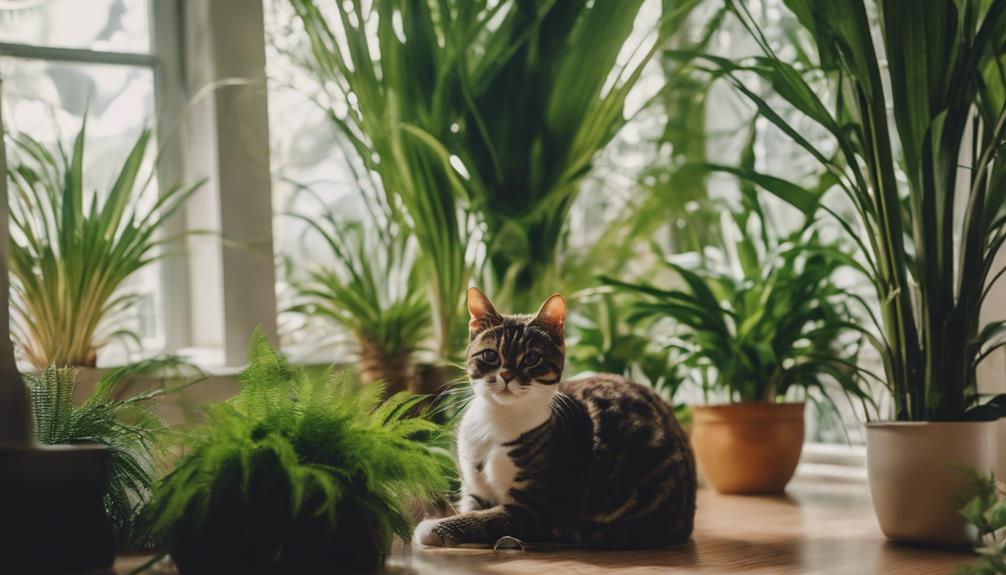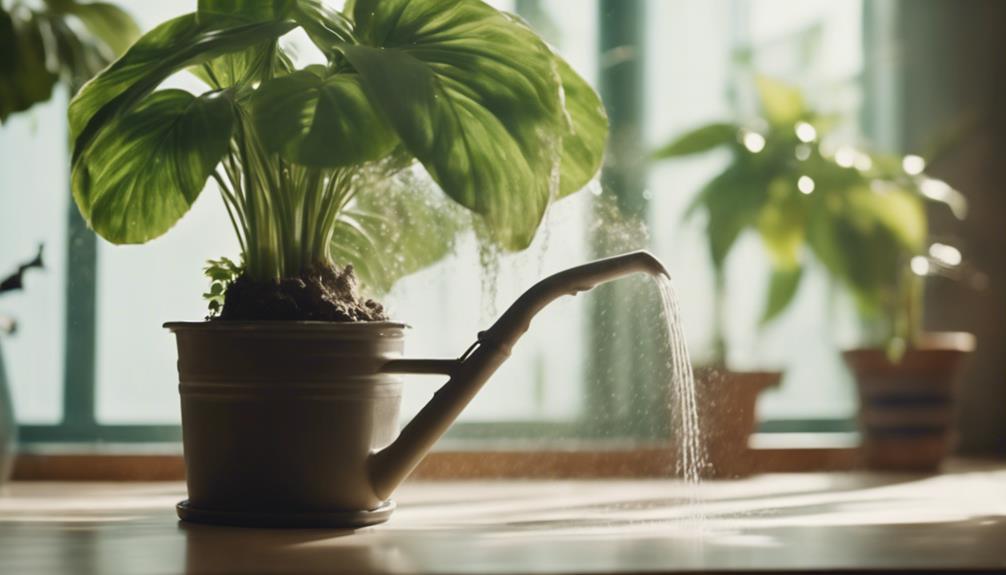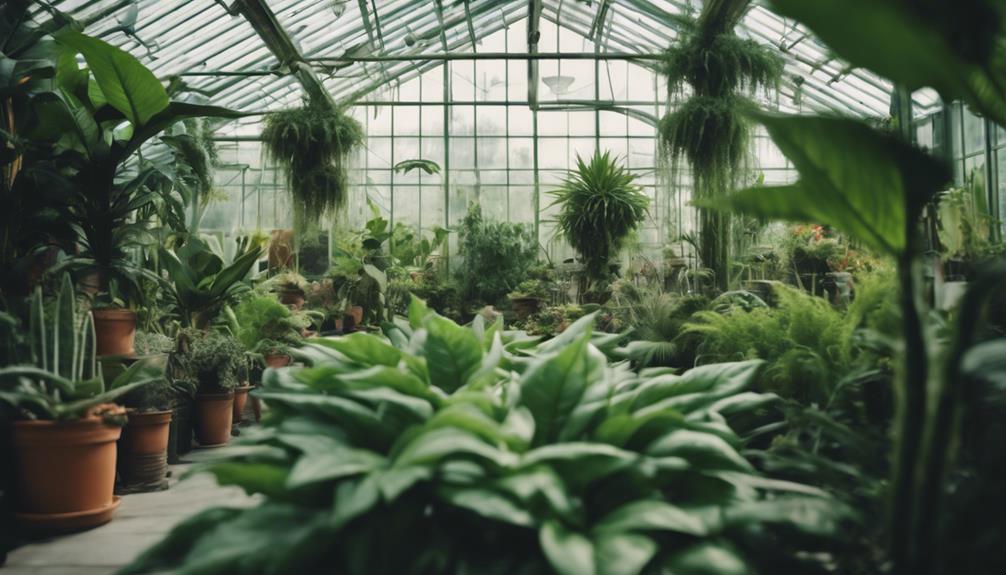Looking to incorporate a tropical feel into your living space? Consider Tropical Fishtail Palms for their vibrant appearance and tall stature. Majestic Money Trees are a symbol of prosperity and do well in well-lit areas. Dwarf Umbrella Trees make elegant additions to any room, but require consistent light and care. The Swiss Cheese Plant adds a touch of exotic beauty with its uniquely shaped leaves. Yuccas bring a desert-like vibe with their sharp leaves and low watering needs. Areca Palm not only purifies the air, but also adds a touch of sophistication to your space. Check out our Yucca Plant Care Tips to ensure your plants stay healthy and flourishing. Our rubber plant maintenance tips and bird of paradise plant ideas can help you create the indoor jungle oasis you desire.
Key Takeaways
- Consider Yuccas for exotic charm and easy maintenance up to 7 feet tall.
- Opt for Areca Palms for elegant jungle vibes, air purification, and low maintenance.
- Select a Fiddle Leaf Fig for tropical elegance in bright, indirect light up to 10 feet tall.
- Bird of Paradise plants bring South African exoticism, growing over 6 feet tall.
- Create drama with a tall Yucca plant or a lush setting with clustered Yuccas in varying heights.
Tropical Fishtail Palms for Home
We absolutely love the vibrant addition that Tropical Fishtail Palms bring to our indoor spaces. These massive palms, native to tropical regions like India, Myanmar, and Sri Lanka, infuse our homes with jungle vibes and a touch of exotic beauty. Standing tall at heights of up to 10 feet, Fishtail Palms create a striking focal point in any room.
To guarantee that these tropical giants thrive indoors, mimicking their natural habitat is crucial. Maintaining temperatures between 60 to 80 degrees Fahrenheit and providing bright indirect sunlight will keep them happy and healthy. Regular feeding during the summer months and watering when the soil is dry are essential for the well-being of Fishtail Palms.
With their unique fishtail-shaped leaves and impressive size, these palms bring a taste of the jungle right into our living spaces, making them a perfect choice for anyone looking to add a touch of the tropics to their home decor.
Majestic Money Trees Indoors

With their symbolic significance in Chinese culture, Money Trees make a majestic addition to indoor spaces, reaching heights of up to 6 feet. These plants thrive in bright indirect sunlight and require watering every three weeks to maintain their lush appearance.
To create a suitable environment for your Money Tree, consider the following:
- Lighting: Place your Money Tree in a spot that receives bright indirect sunlight to promote healthy growth.
- Watering: Make sure you water your Money Tree every three weeks, allowing the soil to slightly dry out between waterings to prevent overwatering.
- Humidity: Money Trees thrive in a humid environment, so consider misting the leaves occasionally or using a humidifier to maintain ideal humidity levels.
Stunning Dwarf Umbrella Trees Selection

Moving on from the majestic Money Trees, let's now explore the stunning selection of Dwarf Umbrella Trees for your indoor space. These indoor plants, also known as Schefflera arboricola, can grow to heights of 4 to 5 feet, making them a perfect choice for those looking to add a touch of tropical vibe to their homes.
Originating from Taiwan, Dwarf Umbrella Trees thrive in bright indirect light, needing to be shielded from cold drafts and air conditioning vents. To guarantee the health of your Dwarf Umbrella Trees, maintain a consistent temperature range between 60 to 80 degrees. Regular watering and a stable temperature of 65 to 85 degrees can help these plants flourish year-round, providing an elegant and vibrant addition to your indoor oasis.
With their beautifully arranged leaves and manageable size, Dwarf Umbrella Trees are a popular choice for plant enthusiasts seeking to bring a bit of the tropics indoors.
Swiss Cheese Plant: Indoor Majesty

We're about to discuss the Swiss Cheese Plant, a majestic indoor addition that brings a touch of tropical charm into your home.
Let's talk about how to care for this plant, the benefits it offers, and some stylish ways to incorporate it into your decor.
Get ready to elevate your indoor jungle game with the Swiss Cheese Plant!
Swiss Cheese Plant Care
Let's explore important care tips for the majestic Swiss Cheese Plant, also known as Monstera deliciosa, to help you maintain its vibrant growth indoors.
- Lighting: Position your Swiss Cheese Plant in a spot with bright, indirect light to keep it thriving. Direct sunlight can scorch its leaves, so finding that essential balance is key.
- Watering Schedule: Establish a regular watering routine for your plant, allowing the top inch of soil to dry out between waterings. Overwatering can lead to root rot, so it's important to strike a balance.
- Temperature: Maintain a consistent temperature range of 65 to 85 degrees Fahrenheit year-round to provide the ideal environment for your Swiss Cheese Plant's growth. Fluctuations outside this range can stress the plant.
Benefits of Swiss Cheese Plant
Starting with the majestic Swiss Cheese Plant, its impressive height potential and unique split leaves contribute to its status as an indoor majesty, bringing a touch of tropical elegance to any living space. The Swiss Cheese Plant, also known as Monstera deliciosa, can grow up to 8 feet tall indoors, creating a lush, green focal point in your home. This plant thrives in bright but indirect light, making it an ideal choice for indoor spaces with ample natural light. Regular watering and a temperature range of 65 to 85 degrees Fahrenheit year-round help maintain the Swiss Cheese Plant's health and growth. With its striking appearance and easy care requirements, the Swiss Cheese Plant is a popular choice for those looking to add a touch of the tropics to their indoor jungle setting. Embrace the beauty and elegance of the Swiss Cheese Plant as it flourishes in your indoor oasis.
| Benefits of Swiss Cheese Plant |
|---|
| Impressive height potential |
| Unique split leaves |
| Thrives in bright, indirect light |
| Easy care requirements |
| Adds tropical elegance indoors |
Styling With Swiss Cheese
Styling with the majestic Swiss Cheese Plant in your indoor space can elevate the ambiance with its tropical elegance and impressive height potential. Here are three tips to make the most of this stunning plant:
- Placement is Key: Position your Swiss Cheese Plant in an area that receives bright indirect light, such as near a window with sheer curtains. This will help the plant thrive and maintain its vibrant foliage, adding a touch of jungle vibes to your home.
- Accessorize with Elegance: Utilize decorative pots or plant stands to complement the tropical elegance of the Swiss Cheese Plant. Choose containers that enhance the overall aesthetic of your indoor space while allowing the plant to shine as a focal point.
- Regular Care Routine: Establish a consistent watering schedule and keep the temperature within the best range of 65 to 85 degrees Fahrenheit year-round. Rotate the plant periodically for even growth and light exposure, appreciating the majestic presence it brings to your home decor.
Yuccas: Indoor Tropical Charm

Yuccas are tropical plants that bring a touch of exotic charm to indoor spaces. These plants are known for their sword-shaped leaves and can reach heights of up to 7 feet. They thrive in bright, direct sunlight.
To care for yuccas successfully, it's essential to water them infrequently. Allow the soil to dry out between waterings to prevent overwatering and root rot.
Yucca Care Tips
We regularly keep our indoor Yucca plants thriving by providing them with bright indirect sunlight and watering them only when the soil is dry. Here are three essential care tips for your Yucca plants:
- Sunshine Requirements: Yuccas are sun-loving plants and thrive in bright direct sunlight. Placing them in a well-lit area away from harsh direct sunlight will help them grow and flourish.
- Watering Guidelines: To maintain healthy Yucca plants, water them infrequently. Check the soil moisture by inserting your finger into the soil; water only when the top few inches are dry. Overwatering can lead to root rot, so it's important to let the soil dry out between waterings.
- Low Maintenance Appeal: Yuccas are known for being low maintenance indoor tropical plants. Their tolerance to temperature changes and dry air, paired with minimal watering needs, make them an ideal choice for those seeking an exotic touch in their home with ease of care.
Yucca Decor Ideas
Maintaining a vibrant indoor aesthetic with Yucca plants extends beyond their care routine; incorporating these tropical beauties into your decor can effortlessly enhance your living space. Yuccas, with their sword-shaped leaves and tall stature, are ideal for creating a jungle vibe indoors. To infuse your home with a tropical feel, consider the following Yucca decor ideas:
| Yucca Decor Ideas | Description |
|---|---|
| Large Yucca as a Focal Point | Place a tall Yucca plant in a corner to add drama and height to the room. Its striking appearance will draw the eye and create a jungle-like atmosphere. |
| Yucca Cluster for Greenery | Group several Yucca plants together in varying heights to mimic a lush tropical setting. This cluster arrangement can fill empty spaces and provide a cohesive green backdrop. |
| Yucca in Modern Planters | Showcase your Yucca in sleek, modern planters to juxtapose the plant's natural charm with contemporary decor. Choose pots that complement your interior style for a cohesive look. |
Large Fiddle Leaf Fig Guide
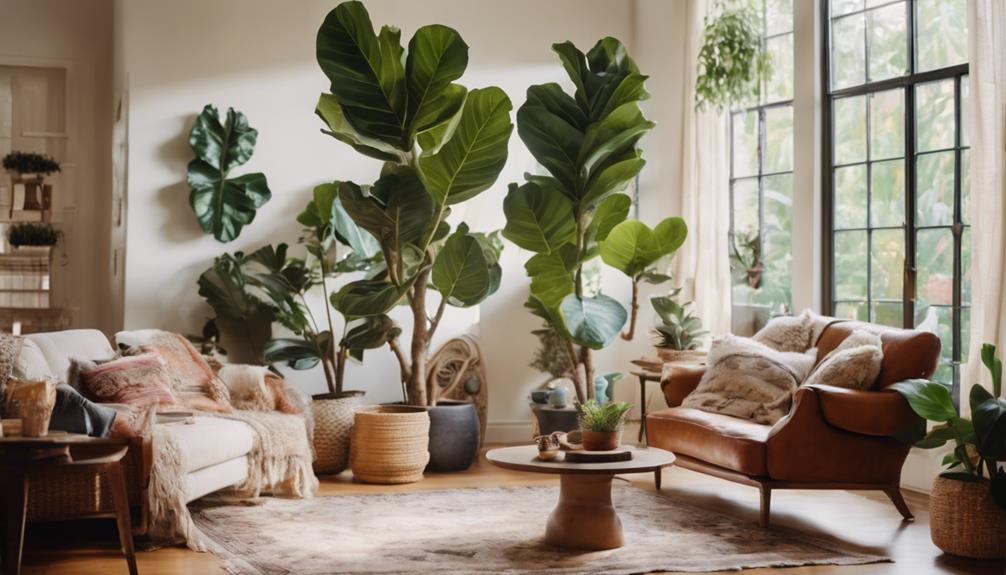
When considering large indoor plants, the Fiddle Leaf Fig stands out as a stunning choice due to its iconic fiddle-shaped leaves and impressive height potential of up to 10 feet.
Here's a guide to help you care for and enjoy this beautiful addition to your indoor jungle:
- Light Requirements: The Fiddle Leaf Fig, a member of the Ficus family, thrives in bright, indirect light. Placing it near a window where it can receive plenty of sunlight without direct exposure will help it flourish.
- Height Management: Regular pruning can help control the growth of your Fiddle Leaf Fig, ensuring it remains a manageable size within your space while promoting a bushier appearance.
- Watering Routine: To prevent root rot, it's important to water your Fiddle Leaf Fig consistently. Allow the top inch of soil to dry out between waterings, and maintain proper drainage to keep the roots healthy.
With these care tips, your Fiddle Leaf Fig can bring a touch of elegance and tropical charm to your home.
Areca Palm for Indoor Greenery

Areca Palms bring a touch of the tropics to your indoor space with their tall, feathery fronds.
To care for your Areca, remember to place it in bright, indirect light and water when the soil is dry.
Styling with an Areca Palm can instantly elevate your decor, creating a lush, green atmosphere in any room.
Areca Palm Benefits
Indoor greenery enthusiasts can reap numerous benefits by incorporating the vibrant Areca Palm into their living spaces. Here are three key advantages of adding this tropical beauty to your indoor oasis:
- Air Purification: The Areca Palm acts as a natural air purifier, effectively filtering out harmful toxins like formaldehyde and toluene, thereby promoting cleaner and fresher air in your home.
- Impressive Height: With the potential to grow up to 7 feet tall, the Areca Palm makes a bold statement in any room, adding a touch of elegance and grandeur to your indoor spaces.
- Thrives in Bright, Indirect Light: Known for its ability to thrive in bright, indirect light conditions, the Areca Palm is perfect for indoor environments where direct sunlight may be limited. This adaptability ensures that your plant stays healthy and vibrant, enhancing the tropical ambiance of your home.
Care Tips for Areca
To guarantee the best growth and health of your Areca Palm, follow these straightforward care tips for indoor greenery enthusiasts.
The Areca Palm, a popular indoor plant known for its tropical charm, thrives in bright indirect sunlight. Place it near a window where it can receive this type of light to keep its lush green fronds vibrant.
Regular watering is essential to maintain moist soil for the Areca Palm. Remember to water when the top inch of the soil feels dry to the touch.
This plant's air-purifying qualities make it a great choice for enhancing indoor air quality and promoting well-being.
Despite its elegant appearance, the Areca Palm is relatively low-maintenance, making it perfect for beginners or those seeking an easy-care indoor plant option.
Styling With Areca Palm
When incorporating the elegant Areca Palm into your indoor greenery decor, consider its striking height potential and tropical aesthetic for a rejuvenating touch.
This tropical palm is perfect for creating jungle vibes in your home.
Here are three key points to keep in mind when styling with the Areca Palm:
- Placement: Position your Areca Palm in a spot that receives bright sunlight but avoid direct exposure to harsh rays. This will help the plant thrive and maintain its vibrant green fronds.
- Height Considerations: Given its impressive height potential of up to 7 feet indoors, the Areca Palm serves as a statement piece in any room. Be mindful of its growth trajectory and choose a spacious area where it can flourish without restriction.
- Complementary Plants: Pairing the Areca Palm with other indoor trees or plants that share its love for bright, indirect sunlight can enhance the overall tropical ambiance of your living space. Consider adding complementary foliage to create a lush indoor jungle.
Yucca Plant Care Tips

Given their origins in Central and South America, caring for yucca plants indoors involves specific considerations to guarantee their best growth and health. Yucca plants can reach heights of up to 7 feet indoors, making them a striking addition to any indoor space.
These plants are hardy and can adapt well to temperature changes and dry air conditions. To make sure your yucca thrives, place it in a spot with bright direct sunlight, as they love soaking up the sun's rays.
When it comes to watering, remember to do so infrequently, only when the soil is dry. Overwatering can harm yucca plants, so it's best to err on the side of underwatering.
With their low-maintenance nature and eye-catching appearance, yucca plants are an excellent choice for adding a touch of greenery to your indoor sanctuary.
Rubber Plant Maintenance Guide

The Rubber Plant Maintenance Guide provides essential care instructions for keeping your Ficus elastica thriving indoors.
Light and Temperature: Place your Rubber Plant in an area with bright, indirect light and maintain temperatures between 60 to 75 degrees Fahrenheit for best growth.
Watering Schedule: Water your Rubber Plant when the top inch of soil feels dry, usually every 1-2 weeks. Reduce watering frequency during the winter months to prevent overwatering.
Maintenance Tips: Prune any yellow or damaged leaves to promote new growth and maintain the plant's appearance. Wipe the glossy leaves with a damp cloth regularly to keep them clean and help the plant photosynthesize efficiently.
Bird of Paradise Plant Ideas
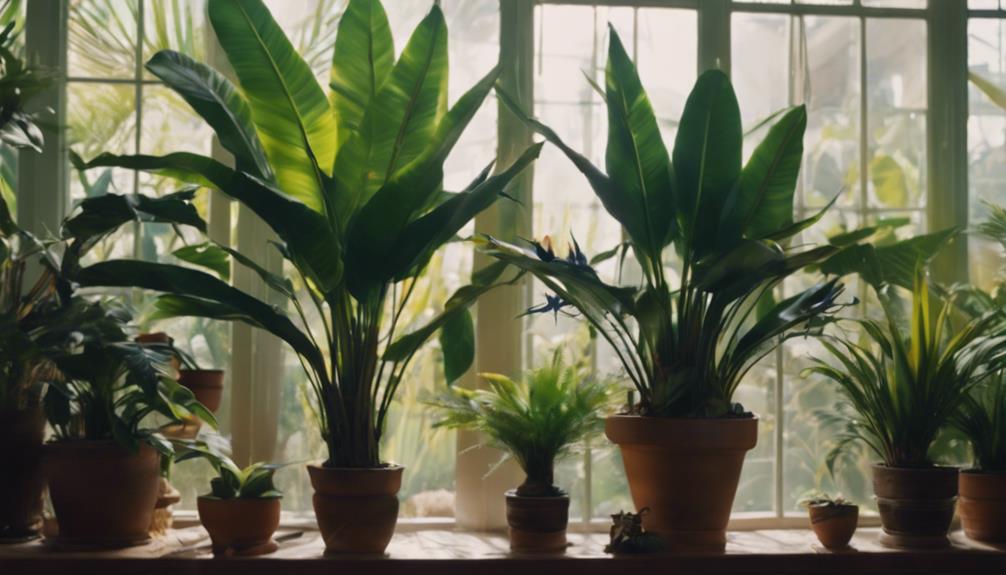
Exploring creative ways to showcase the Bird of Paradise plant elevates indoor greenery to new heights of sophistication and tropical allure. The Bird of Paradise, also known as Strelitzia Nicolai, is a stunning tropical plant that can grow over 6 feet tall, boasting impressive banana-like leaves and vibrant bird-shaped flowers. Originating from South Africa, this exotic beauty thrives in bright, indirect light and requires regular watering to maintain soil moisture levels without overwatering.
Adding a Bird of Paradise plant to your indoor jungle brings a touch of exotic elegance, transforming your living space into a tropical oasis. With its striking appearance and graceful presence, this large indoor plant becomes a focal point, enhancing the overall aesthetic of your home.
Frequently Asked Questions
What Is the Most Sought After Houseplant?
The most sought after houseplant is the Fiddle Leaf Fig (Ficus Lyrata). It stands out for its large, glossy leaves and elegant appearance.
This plant is favored for its ability to turn spaces into lush indoor jungles, making it a top pick for interior designers and plant enthusiasts.
Apart from its aesthetic appeal, the Fiddle Leaf Fig is valued for its air-purifying qualities, enhancing indoor air quality.
With proper care, it can grow up to 10 feet tall, serving as a striking focal point in any room.
What Is the Hardest Indoor Plant to Keep Alive?
The Fiddle Leaf Fig is widely considered one of the trickiest indoor plants to keep alive. Its finicky nature demands bright, indirect light and precise watering, making it a challenge for many.
Mistakes like overwatering or underwatering can quickly lead to root rot or leaf loss, adding to its reputation for being tough to care for. Beginners often struggle due to its sensitivity to changes in light, temperature, and humidity levels.
What Is the Best Indoor Tall Plant?
When looking for the best indoor tall plant, we recommend considering the Fiddle Leaf Fig, Areca Palm, Yucca, Rubber Plant, or Bird of Paradise. These plants can reach heights of 1m or more, adding a green focal point to any room.
Besides enhancing decor, large plants like the Peace Lily and Calathea also purify the air and boost wellbeing. Remember to assess their maintenance requirements, including lighting, watering, and space needs for peak growth.
What Is the Most Beneficial Indoor Plant?
When it comes to the most beneficial indoor plant, the Snake Plant takes the crown. Its air-purifying abilities rid your space of harmful toxins like formaldehyde and benzene.
This low-maintenance plant is perfect for beginners, needing little water and thriving in low light. Additionally, it converts carbon dioxide into oxygen at night, making it a great bedroom companion for improved sleep quality.
With its striking look and vertical growth, the Snake Plant is both visually appealing and functional.
Can Massive Indoor Plants Thrive in a Regular Home Environment?
Yes, there are great big indoor plants options that can thrive in a regular home environment. Some popular choices include the fiddle leaf fig, the snake plant, and the monstera. These larger plants are adaptable to indoor conditions and can thrive with the right care and maintenance.
Conclusion
To sum up, when contemplating bringing jungle vibes into your home with massive indoor plants, it's easier than you might think. Did you know that indoor plants can increase productivity by 15%?
With options like Tropical Fishtail Palms, Money Trees, and Swiss Cheese Plants, you can create a lush oasis in any space. Keep in mind lighting, watering, and care tips to keep your indoor jungle thriving and vibrant.
Happy planting!



